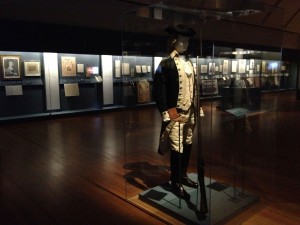 An election year offers the opportunity to contemplate the marvels of the Founding Fathers breaking apart from Great Britain and creating the democratic nation that we enjoy (and vote in) today. A new exhibit at the Skirball Cultural Center, Creating the United States, has on display rare, historical artifacts and documents from the early days of democracy that have been carefully gathered from the Library of Congress, the Smithsonian and the Huntington Library. It’s exciting to have these rarities in Southern California, and the spin put on the material by the Skirball is particularly intriguing.
An election year offers the opportunity to contemplate the marvels of the Founding Fathers breaking apart from Great Britain and creating the democratic nation that we enjoy (and vote in) today. A new exhibit at the Skirball Cultural Center, Creating the United States, has on display rare, historical artifacts and documents from the early days of democracy that have been carefully gathered from the Library of Congress, the Smithsonian and the Huntington Library. It’s exciting to have these rarities in Southern California, and the spin put on the material by the Skirball is particularly intriguing.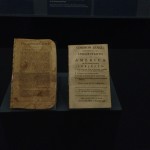
First, the marvels on display. The show introduces visitors to the three archival treasures that civics students travel to Washington DC to see each year — the Declaration of Independence, the Constitution and the Bill of Rights. It’s exciting to gaze upon one of only a few “stone copies” that exist of the Declaration of Independence (that’s a long way from a xerox, ladies and gentlemen!). Thomas Jefferson’s writing desk (an old-fashioned pencil box, really), and a cool device for copying signatures created by George Washington (with dueling quills) are items kids will love.
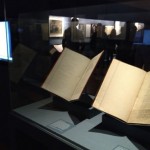 Nearby, is an original first edition of Thomas Paine’s Common Sense, one of history’s most radical treatises. If you have students learning about primary sources, they’ll enjoy reading letters from soldiers at Valley Forge and reading “autograph letters” from John Adams and George Washington describing their early struggles both to reach assent amongst the Continental Congress and then implement the ideals of the new democracy. (What exactly does “advise and consent” actually mean?!)
Nearby, is an original first edition of Thomas Paine’s Common Sense, one of history’s most radical treatises. If you have students learning about primary sources, they’ll enjoy reading letters from soldiers at Valley Forge and reading “autograph letters” from John Adams and George Washington describing their early struggles both to reach assent amongst the Continental Congress and then implement the ideals of the new democracy. (What exactly does “advise and consent” actually mean?!)
The coolest part of the show is that next to each original draft of these archival treasures is an interactive screen that allows visitors both to read the actual content in legible fashion, but also see how the edits of the Founders were implemented. You can literally read edits made by Washington himself, right next to another source that likely influenced that author’s train of thought. It’s almost like being present in the room while the editing was going on, and elegantly underlines the notion that these were regular people making historic choices. This living-breathing access to history makes the exhibit a revelation, even for those who have been to Washington and visited the National Archives.
The last part of the main exhibit demonstrates the legacy of these documents as the central issues of freedom went on to be explored – in the wages of subsequent generations in women’s suffrage, slavery, Native American rights, Japanese internment and the struggles of the United Farm Workers.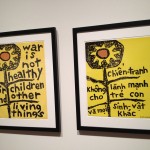
The elasticity of our democratic ideals are also explored in two adjunct exhibits, both of which are slightly more accessible to a younger audience — in a colorful display of political posters, Decades of Dissent, which showcases the familiar (Make Love, Not War,” “Black is Beautiful,” and “War is not healthy for children and other living things”) and unusual (Rauchenberg’s poster for the first Earth Day).
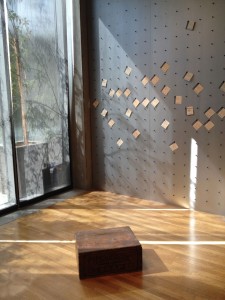 In a final room, kids can explore how protecting these freedoms is still an active part of a civic education – they can even climb up on a soapbox and spout their own ideals. After visiting this exhibit, it’d be nice to think they’ve learned a little bit about where those rights came from. Now… if only they could vote in this election!
In a final room, kids can explore how protecting these freedoms is still an active part of a civic education – they can even climb up on a soapbox and spout their own ideals. After visiting this exhibit, it’d be nice to think they’ve learned a little bit about where those rights came from. Now… if only they could vote in this election!

